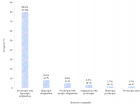Abstract
Review Article
Eco-friendly microplastic removal through physical and chemical techniques: a review
Mohammad R Alrbaihat* and Qusay Abu-Afifeh
Published: 31 January, 2023 | Volume 7 - Issue 1 | Pages: 014-024
A growing number of synthetic plastics derived from fossil fuels are produced, and improper plastic waste management has caused a lot of pollution problems. There are many microplastics in the environment, and they disintegrate slowly in soil and water. The properties of microplastics (MPs) include long residence times, high stability, high fragmentation potential, and the ability to adsorb other contaminants. Invertebrates and planktonic organisms are easily able to accumulate microplastics in aquatic species. Therefore, microplastics (MPs) must be removed from the water and other media. This paper aims to review the occurrence, raw polymers and additives, and remediation methods for removing microplastics from the environment. Several methods are available for removing contaminants, including sorption, filtration and chemical treatments. Various removal methods are discussed along with their methods, efficiency and advantages.
Read Full Article HTML DOI: 10.29328/journal.aac.1001038 Cite this Article Read Full Article PDF
Keywords:
Microplastics; Physical methods; Removal techniques; Membrane-based; Chemical treatments
References
- Padervand M, Lichtfouse E, Robert D, Wang C. Removal of microplastics from the environment. A review. Environ Chem Lett. 2020; 18: 807-828. doi: 10.1007/s10311-020-00983-1.
- Al-Rawajfeh AE, AlShamaileh EM, Alrbaihat MR. Clean and efficient synthesis using mechanochemistry: Preparation of kaolinite–KH 2 PO 4 and kaolinite–(NH 4 ) 2 HPO 4 complexes as slow released fertilizer. J Ind Eng Chem. 2019; 73: 336–343. 2019.
- Kumar A, Yedhu Krishnan R. A Review on the Technology of Size Reduction Equipment. Int J ChemTech Res. 2020; 13: 48-54. doi: 10.20902/ijctr.2019.130106.
- Esnouf A, Latrille É, Steyer JP, Helias A. Representativeness of environmental impact assessment methods regarding Life Cycle Inventories. Sci Total Environ. 2018 Apr 15;621:1264-1271. doi: 10.1016/j.scitotenv.2017.10.102. Epub 2017 Oct 19. PMID: 29055597.
- Van Cauwenberghe L, Vanreusel A, Mees J, Janssen CR. Microplastic pollution in deep-sea sediments. Environ Pollut. 2013 Nov;182:495-9. doi: 10.1016/j.envpol.2013.08.013. Epub 2013 Sep 12. PMID: 24035457.
- Hirai H, Takada H, Ogata Y, Yamashita R, Mizukawa K, Saha M, Kwan C, Moore C, Gray H, Laursen D, Zettler ER, Farrington JW, Reddy CM, Peacock EE, Ward MW. Organic micropollutants in marine plastics debris from the open ocean and remote and urban beaches. Mar Pollut Bull. 2011 Aug;62(8):1683-92. doi: 10.1016/j.marpolbul.2011.06.004. Epub 2011 Jun 29. PMID: 21719036.
- Faure F, Demars C, Wieser O, Kunz M, de Alencastro LF. Plastic pollution in Swiss surface waters: nature and concentrations, interaction with pollutants. (Special Issue: Microplastics in the environment.). Environ Chem. 2015; 12: 582–591.
- Law KL, Morét-Ferguson SE, Goodwin DS, Zettler ER, Deforce E, Kukulka T, Proskurowski G. Distribution of surface plastic debris in the eastern Pacific Ocean from an 11-year data set. Environ Sci Technol. 2014 May 6;48(9):4732-8. doi: 10.1021/es4053076. Epub 2014 Apr 24. PMID: 24708264.
- Andrady AL. Microplastics in the marine environment. Mar Pollut Bull. 2011; 62: 1596-1605. doi: 10.1016/j.marpolbul.2011.05.030.
- Noyma NP, de Magalhães L, Furtado LL, Mucci M, van Oosterhout F, Huszar VL, Marinho MM, Lürling M. Controlling cyanobacterial blooms through effective flocculation and sedimentation with combined use of flocculants and phosphorus adsorbing natural soil and modified clay. Water Res. 2016 Jun 15;97:26-38. doi: 10.1016/j.watres.2015.11.057. Epub 2015 Dec 8. PMID: 26706124.
- Pathak VM, Navneet, Review on the current status of polymer degradation: a microbial approach. Bioresour Bioprocess. 2017; 4. doi: 10.1186/s40643-017-0145-9.
- Li J, Liu H, Paul Chen J. Microplastics in freshwater systems: A review on occurrence, environmental effects, and methods for microplastics detection. Water Res. 2018 Jun 15;137:362-374. doi: 10.1016/j.watres.2017.12.056. Epub 2017 Dec 28. PMID: 29580559.
- Sussarellu R, Suquet M, Thomas Y, Lambert C, Fabioux C, Pernet ME, Le Goïc N, Quillien V, Mingant C, Epelboin Y, Corporeau C, Guyomarch J, Robbens J, Paul-Pont I, Soudant P, Huvet A. Oyster reproduction is affected by exposure to polystyrene microplastics. Proc Natl Acad Sci U S A. 2016 Mar 1;113(9):2430-5. doi: 10.1073/pnas.1519019113. Epub 2016 Feb 1. PMID: 26831072; PMCID: PMC4780615.
- Meeker JD, Sathyanarayana S, Swan SH. Phthalates and other additives in plastics: human exposure and associated health outcomes. Philos Trans R Soc Lond B Biol Sci. 2009 Jul 27;364(1526):2097-113. doi: 10.1098/rstb.2008.0268. PMID: 19528058; PMCID: PMC2873014.
- Piringer OG, Baner AL. Permeation of gases, water vapor and volatile organic compounds. Plast Packag Mater food barrier Funct. mass Transp. Qual. Assur. Legis. 2000; 250.
- Lau OW, Wong SK. Contamination in food from packaging material. J Chromatogr A. 2000; 882: 255-270.
- Nobre CR, Santana MFM, Maluf A, Cortez FS, Cesar A, Pereira CDS, Turra A. Assessment of microplastic toxicity to embryonic development of the sea urchin Lytechinus variegatus (Echinodermata: Echinoidea). Mar Pollut Bull. 2015 Mar 15;92(1-2):99-104. doi: 10.1016/j.marpolbul.2014.12.050. Epub 2015 Feb 7. PMID: 25662316.
- Wang W, Ndungu AW, Li Z, Wang J. Microplastics pollution in inland freshwaters of China: A case study in urban surface waters of Wuhan, China. Sci Total Environ. 2017 Jan 1;575:1369-1374. doi: 10.1016/j.scitotenv.2016.09.213. Epub 2016 Sep 29. PMID: 27693147.
- Schwabl P, Köppel S, Königshofer P, Bucsics T, Trauner M, Reiberger T, Liebmann B. Detection of Various Microplastics in Human Stool: A Prospective Case Series. Ann Intern Med. 2019 Oct 1;171(7):453-457. doi: 10.7326/M19-0618. Epub 2019 Sep 3. PMID: 31476765.
- Vickers NJ. Animal Communication: When I'm Calling You, Will You Answer Too? Curr Biol. 2017 Jul 24;27(14):R713-R715. doi: 10.1016/j.cub.2017.05.064. PMID: 28743020.
- Zhang C, Chen X, Wang J, Tan L. Toxic effects of microplastic on marine microalgae Skeletonema costatum: Interactions between microplastic and algae. Environ Pollut. 2017 Jan;220(Pt B):1282-1288. doi: 10.1016/j.envpol.2016.11.005. Epub 2016 Nov 18. PMID: 27876228.
- Au SY, Bruce TF, Bridges WC, Klaine SJ. Responses of Hyalella azteca to acute and chronic microplastic exposures. Environ Toxicol Chem. 2015 Nov;34(11):2564-72. doi: 10.1002/etc.3093. Epub 2015 Sep 23. PMID: 26042578.
- Kirstein IV, Kirmizi S, Wichels A, Garin-Fernandez A, Erler R, Löder M, Gerdts G. Dangerous hitchhikers? Evidence for potentially pathogenic Vibrio spp. on microplastic particles. Mar Environ Res. 2016 Sep;120:1-8. doi: 10.1016/j.marenvres.2016.07.004. Epub 2016 Jul 5. PMID: 27411093.
- Prata JC. Airborne microplastics: Consequences to human health? Environ Pollut. 2018 Mar;234:115-126. doi: 10.1016/j.envpol.2017.11.043. Epub 2017 Dec 21. PMID: 29172041.
- Jiang JQ. Occurrence of microplastics and its pollution in the environment: A review. Sustain Prod Consum. 2018; 13: 16–23. doi: 10.1016/j.spc.2017.11.003.
- Besseling E, Wang B, Lürling M, Koelmans AA. Nanoplastic affects growth of S. obliquus and reproduction of D. magna. Environ Sci Technol. 2014 Oct 21;48(20):12336-43. doi: 10.1021/es503001d. Epub 2014 Oct 10. Erratum in: Environ Sci Technol. 2014 Dec 2;48(23):14065. PMID: 25268330; PMCID: PMC6863593.
- Fasano E, Bono-Blay F, Cirillo T, Montuori P, Lacorte S. Migration of phthalates, alkylphenols, bisphenol A and di(2-ethylhexyl)adipate from food packaging. Food Control. 2012; 27: 132–138.
- Talsness CE, Andrade AJ, Kuriyama SN, Taylor JA, vom Saal FS. Components of plastic: experimental studies in animals and relevance for human health. Philos Trans R Soc Lond B Biol Sci. 2009 Jul 27;364(1526):2079-96. doi: 10.1098/rstb.2008.0281. PMID: 19528057; PMCID: PMC2873015.
- Wright SL, Kelly FJ. Plastic and Human Health: A Micro Issue? Environ Sci Technol. 2017 Jun 20;51(12):6634-6647. doi: 10.1021/acs.est.7b00423. Epub 2017 Jun 7. PMID: 28531345.
- Hamidian AH, Ozumchelouei EJ, Feizi F, Wu C, Zhang Y, Yang M. A review on the characteristics of microplastics in wastewater treatment plants: a source for toxic chemicals. J Clean Prod. 2021; 295: 126480.
- Eriksen M, Lebreton LC, Carson HS, Thiel M, Moore CJ, Borerro JC, Galgani F, Ryan PG, Reisser J. Plastic Pollution in the World's Oceans: More than 5 Trillion Plastic Pieces Weighing over 250,000 Tons Afloat at Sea. PLoS One. 2014 Dec 10;9(12):e111913. doi: 10.1371/journal.pone.0111913. PMID: 25494041; PMCID: PMC4262196.
- Thompson RC, Moore CJ, vom Saal FS, Swan SH. Plastics, the environment and human health: current consensus and future trends. Philos Trans R Soc Lond B Biol Sci. 2009 Jul 27;364(1526):2153-66. doi: 10.1098/rstb.2009.0053. PMID: 19528062; PMCID: PMC2873021.
- Browne MA, Crump P, Niven SJ, Teuten E, Tonkin A, Galloway T, Thompson R. Accumulation of microplastic on shorelines woldwide: sources and sinks. Environ Sci Technol. 2011 Nov 1;45(21):9175-9. doi: 10.1021/es201811s. Epub 2011 Oct 4. PMID: 21894925.
- Long Z, Pan Z, Wang W, Ren J, Yu X, Lin L, Lin H, Chen H, Jin X. Microplastic abundance, characteristics, and removal in wastewater treatment plants in a coastal city of China. Water Res. 2019 May 15;155:255-265. doi: 10.1016/j.watres.2019.02.028. Epub 2019 Feb 25. PMID: 30852313.
- Murphy F, Ewins C, Carbonnier F, Quinn B. Wastewater Treatment Works (WwTW) as a Source of Microplastics in the Aquatic Environment. Environ Sci Technol. 2016 Jun 7;50(11):5800-8. doi: 10.1021/acs.est.5b05416. Epub 2016 May 18. PMID: 27191224.
- Jin L, Zhang G, Tian H. Current state of sewage treatment in China. Water Res. 2014 Dec 1;66:85-98. doi: 10.1016/j.watres.2014.08.014. Epub 2014 Aug 22. PMID: 25189479.
- Sun J, Dai X, Wang Q, van Loosdrecht MCM, Ni BJ. Microplastics in wastewater treatment plants: Detection, occurrence and removal. Water Res. 2019 Apr 1;152:21-37. doi: 10.1016/j.watres.2018.12.050. Epub 2019 Jan 2. PMID: 30660095.
- Carr SA, Liu J, Tesoro AG. Transport and fate of microplastic particles in wastewater treatment plants. Water Res. 2016 Mar 15;91:174-82. doi: 10.1016/j.watres.2016.01.002. Epub 2016 Jan 7. PMID: 26795302.
- Bui XT, Nguyen PT, Nguyen VT, Dao TS, Nguyen PD. Microplastics pollution in wastewater: Characteristics, occurrence and removal technologies. Environ Technol Innov. 2020; 19: 101013.
- Magni S, Binelli A, Pittura L, Avio CG, Della Torre C, Parenti CC, Gorbi S, Regoli F. The fate of microplastics in an Italian Wastewater Treatment Plant. Sci Total Environ. 2019 Feb 20;652:602-610. doi: 10.1016/j.scitotenv.2018.10.269. Epub 2018 Oct 21. PMID: 30368189.
- Hidayaturrahman H, Lee TG. A study on characteristics of microplastic in wastewater of South Korea: Identification, quantification, and fate of microplastics during treatment process. Mar Pollut Bull. 2019 Sep;146:696-702. doi: 10.1016/j.marpolbul.2019.06.071. Epub 2019 Jul 19. PMID: 31426211.
- Östman M, Björlenius B, Fick J, Tysklind M. Effect of full-scale ozonation and pilot-scale granular activated carbon on the removal of biocides, antimycotics and antibiotics in a sewage treatment plant. Sci Total Environ. 2019 Feb 1;649:1117-1123. doi: 10.1016/j.scitotenv.2018.08.382. Epub 2018 Aug 28. PMID: 30308883.
- Talvitie J, Mikola A, Koistinen A, Setälä O. Solutions to microplastic pollution - Removal of microplastics from wastewater effluent with advanced wastewater treatment technologies. Water Res. 2017 Oct 15;123:401-407. doi: 10.1016/j.watres.2017.07.005. Epub 2017 Jul 2. PMID: 28686942.
- Lares M, Ncibi MC, Sillanpää M, Sillanpää M. Occurrence, identification and removal of microplastic particles and fibers in conventional activated sludge process and advanced MBR technology. Water Res. 2018 Apr 15;133:236-246. doi: 10.1016/j.watres.2018.01.049. Epub 2018 Feb 3. PMID: 29407704.
- Anastasiou E, Lorentz KO, Stein GJ, Mitchell PD. Prehistoric schistosomiasis parasite found in the Middle East. Lancet Infect Dis. 2014 Jul;14(7):553-4. doi: 10.1016/S1473-3099(14)70794-7. PMID: 24953264.
- Gurung K, Ncibi MC, Fontmorin JM. Incorporating Submerged MBR in Conventional Activated Sludge Process for Municipal Wastewater Treatment: A Feasibility and Performance Assessment. J Membr Sci Technol. 2016; 6. doi: 10.4172/2155-9589.1000158.
- Mintenig SM, Int-Veen I, Löder MGJ, Primpke S, Gerdts G. Identification of microplastic in effluents of waste water treatment plants using focal plane array-based micro-Fourier-transform infrared imaging. Water Res. 2017 Jan 1;108:365-372. doi: 10.1016/j.watres.2016.11.015. Epub 2016 Nov 4. PMID: 27838027.
- Ma B, Xue W, Ding Y, Hu C, Liu H, Qu J. Removal characteristics of microplastics by Fe-based coagulants during drinking water treatment. J Environ Sci (China). 2019 Apr;78:267-275. doi: 10.1016/j.jes.2018.10.006. Epub 2018 Oct 30. PMID: 30665645.
- Horton AA, Dixon SJ. Microplastics: An introduction to environmental transport processes. WIREs Water. 2018; 5: 1-10.
- Yang L, Li K, Cui S, Kang Y, An L, Lei K. Removal of microplastics in municipal sewage from China's largest water reclamation plant. Water Res. 2019 May 15;155:175-181. doi: 10.1016/j.watres.2019.02.046. Epub 2019 Feb 26. PMID: 30849731.
- Talvitie J, Mikola A, Setälä O, Heinonen M, Koistinen A. How well is microlitter purified from wastewater? - A detailed study on the stepwise removal of microlitter in a tertiary level wastewater treatment plant. Water Res. 2017 Feb 1;109:164-172. doi: 10.1016/j.watres.2016.11.046. Epub 2016 Nov 16. PMID: 27883921.
- Ersahin ME, Tao Y, Ozgun H, Gimenez JB, Spanjers H, van Lier JB. Impact of anaerobic dynamic membrane bioreactor configuration on treatment and filterability performance. J Memb Sci. 2016; 526: 387-394. doi: 10.1016/j.memsci.2016.12.057.
- Andrady AL. The plastic in microplastics: A review. Mar Pollut Bull. 2017 Jun 15;119(1):12-22. doi: 10.1016/j.marpolbul.2017.01.082. Epub 2017 Apr 24. PMID: 28449819.
- Li L, Xu G, Yu H, Xing J. Dynamic membrane for micro-particle removal in wastewater treatment: Performance and influencing factors. Sci Total Environ. 2018 Jun 15;627:332-340. doi: 10.1016/j.scitotenv.2018.01.239. Epub 2018 Feb 3. PMID: 29426156.
- Talvitie J, Mikola A, Koistinen A, Setälä O. Solutions to microplastic pollution - Removal of microplastics from wastewater effluent with advanced wastewater treatment technologies. Water Res. 2017 Oct 15;123:401-407. doi: 10.1016/j.watres.2017.07.005. Epub 2017 Jul 2. PMID: 28686942.
- Raza W, Lee J, Raza N, Luo Y, Kim KH, Yang J. Removal of phenolic compounds from industrial waste water based on membrane-based technologies. J Ind Eng Chem. 2019; 71: 1-18.
- Cole M, Lindeque P, Halsband C, Galloway TS. Microplastics as contaminants in the marine environment: a review. Mar Pollut Bull. 2011 Dec;62(12):2588-97. doi: 10.1016/j.marpolbul.2011.09.025. Epub 2011 Oct 14. PMID: 22001295.
- Graham ER, Thompson JT. Deposit- and suspension-feeding sea cucumbers (Echinodermata) ingest plastic fragments. J Exp Mar Bio Ecol. 2009; 368: 22-29.
- Wang F. Effects of nanoparticles on algae: Adsorption, distribution, ecotoxicity and fate. Appl Sci. 2019; 9: 1534.
- Rios LM, Moore C, Jones PR. Persistent organic pollutants carried by synthetic polymers in the ocean environment. Mar Pollut Bull. 2007 Aug;54(8):1230-7. doi: 10.1016/j.marpolbul.2007.03.022. Epub 2007 May 29. PMID: 17532349.
- Baur X. Health risks in international container and bulk cargo transport due to volatile toxic compounds. J Occup Med Toxicol. 2015; 10: 1-18.
- Sundbæk KB, Koch IDW, Villaro CG, Rasmussen NS, Holdt SL, Hartmann NB. Sorption of fluorescent polystyrene microplastic particles to edible seaweed Fucus vesiculosus. J Appl Phycol. 2018; 30: 2923–2927. doi: 10.1007/s10811-018-1472-8.
- Martins MJ, Mota CF, Pearson GA. Sex-biased gene expression in the brown alga Fucus vesiculosus. BMC Genomics. 2013 May 1;14:294. doi: 10.1186/1471-2164-14-294. PMID: 23634783; PMCID: PMC3652789.
- Bhattacharya P, Lin S, Turner JP, Ke PC. Physical adsorption of charged plastic nanoparticles affects algal photosynthesis. J Phys Chem C. 2010; 114: 16556-16561.
- Nolte TM, Hartmann NB, Kleijn JM, Garnæs J, van de Meent D, Jan Hendriks A, Baun A. The toxicity of plastic nanoparticles to green algae as influenced by surface modification, medium hardness and cellular adsorption. Aquat Toxicol. 2017 Feb;183:11-20. doi: 10.1016/j.aquatox.2016.12.005. Epub 2016 Dec 8. PMID: 27978483.
- Cheng SY, Show PL, Lau BF, Chang JS, Ling TC. New Prospects for Modified Algae in Heavy Metal Adsorption. Trends Biotechnol. 2019 Nov;37(11):1255-1268. doi: 10.1016/j.tibtech.2019.04.007. Epub 2019 Jun 4. PMID: 31174882.
- Lee KE, Morad N, Teng TT, Poh BT. Development, characterization and the application of hybrid materials in coagulation/flocculation of wastewater: A review. Chem Eng J. 2012; 203: 370-386.
- Chorghe D, Sari MA, Chellam S. Boron removal from hydraulic fracturing wastewater by aluminum and iron coagulation: Mechanisms and limitations. Water Res. 2017 Dec 1;126:481-487. doi: 10.1016/j.watres.2017.09.057. Epub 2017 Sep 28. PMID: 29028491.
- Ariza-Tarazona MC, Villarreal-Chiu JF, Barbieri V, Siligardi C, Cedillo-González EI. New strategy for microplastic degradation: Green photocatalysis using a protein-based porous N-TiO 2 semiconductor. Ceram Int. 2019; 45: 9618-9624. doi: 10.1016/j.ceramint.2018.10.208.
- Liu W, Zhang J, Liu H, Guo X, Zhang X, Yao X, Cao Z, Zhang T. A review of the removal of microplastics in global wastewater treatment plants: Characteristics and mechanisms. Environ Int. 2021 Jan;146:106277. doi: 10.1016/j.envint.2020.106277. Epub 2020 Nov 20. PMID: 33227584.
- Sarkar DJ, Das Sarkar S, Das BK, Praharaj JK, Mahajan DK, Purokait B, Mohanty TR, Mohanty D, Gogoi P, Kumar V S, Behera BK, Manna RK, Samanta S. Microplastics removal efficiency of drinking water treatment plant with pulse clarifier. J Hazard Mater. 2021 Jul 5;413:125347. doi: 10.1016/j.jhazmat.2021.125347. Epub 2021 Feb 9. PMID: 33601144.
- Perren W, Wojtasik A, Cai Q. Removal of Microbeads from Wastewater Using Electrocoagulation. ACS Omega. 2018 Mar 20;3(3):3357-3364. doi: 10.1021/acsomega.7b02037. PMID: 31458591; PMCID: PMC6641227.
- Akbal F, Camcidotless S. Copper, chromium and nickel removal from metal plating wastewater by electrocoagulation. Desalination; 2011; 269: 214–222.
- Zhou G, Wang Q, Li J, Li Q, Xu H, Ye Q, Wang Y, Shu S, Zhang J. Removal of polystyrene and polyethylene microplastics using PAC and FeCl3 coagulation: Performance and mechanism. Sci Total Environ. 2021 Jan 15;752:141837. doi: 10.1016/j.scitotenv.2020.141837. Epub 2020 Aug 20. PMID: 32889273.
- Brandon J, Goldstein M, Ohman MD. Long-term aging and degradation of microplastic particles: Comparing in situ oceanic and experimental weathering patterns. Mar Pollut Bull. 2016 Sep 15;110(1):299-308. doi: 10.1016/j.marpolbul.2016.06.048. Epub 2016 Jun 22. PMID: 27344287.
- Colom X, Cañavate J, Suñol JJ, Pagès P, Saurina J, Carrasco F. Natural and artificial aging of polypropylene-polyethylene copolymers. J Appl Polym Sci. 2002; 87: 1685–1692, 2002, doi: 10.1002/app.11613.
- Hazrat MA, Rasul MG, Khan MMK. A study on thermo-catalytic degradation for production of clean transport fuel and reducing plastic wastes. Procedia Eng. 2014; 105:. 865–876.
- Liu P, Qian L, Wang H, Zhan X, Lu K, Gu C, Gao S. New Insights into the Aging Behavior of Microplastics Accelerated by Advanced Oxidation Processes. Environ Sci Technol. 2019 Apr 2;53(7):3579-3588. doi: 10.1021/acs.est.9b00493. Epub 2019 Mar 13. PMID: 30829479.
- Da Costa JP, Nunes AR, Santos PSM, Girão AV, Duarte AC, Rocha-Santos T. Degradation of polyethylene microplastics in seawater: Insights into the environmental degradation of polymers. J Environ Sci Health A Tox Hazard Subst Environ Eng. 2018 Jul 29;53(9):866-875. doi: 10.1080/10934529.2018.1455381. Epub 2018 Apr 6. PMID: 29624466.
- Zhang K, Hamidian AH, Tubić A, Zhang Y, Fang JKH, Wu C, Lam PKS. Understanding plastic degradation and microplastic formation in the environment: A review. Environ Pollut. 2021 Apr 1;274:116554. doi: 10.1016/j.envpol.2021.116554. Epub 2021 Jan 23. PMID: 33529891.
- Du H, Xie Y, Wang J. Microplastic degradation methods and corresponding degradation mechanism: Research status and future perspectives. J Hazard Mater. 2021 Sep 15;418:126377. doi: 10.1016/j.jhazmat.2021.126377. Epub 2021 Jun 10. PMID: 34130168.
- Klein S, Dimzon IK, Eubeler J, Knepper TP. Analysis, occurrence, and degradation of microplastics in the aqueous environment,” in Freshwater microplastics, Springer, Cham 2018. 51–67.
- Tofa TS, Kunjali KL, Paul S, Dutta J. Visible light photocatalytic degradation of microplastic residues with zinc oxide nanorods. Environ Chem Lett. 2019; 17: 1341-1346.
- Rostami S, Talaie MR, Talaiekhozani A, Sillanpää M. Evaluation of the available strategies to control the emission of microplastics into the aquatic environment. Environ Sci Pollut Res Int. 2021 Apr;28(15):18908-18917. doi: 10.1007/s11356-021-12888-9. Epub 2021 Feb 17. PMID: 33594573.
- Prata JC, Reis V, Matos JTV, da Costa JP, Duarte AC, Rocha-Santos T. A new approach for routine quantification of microplastics using Nile Red and automated software (MP-VAT). Sci Total Environ. 2019 Nov 10;690:1277-1283. doi: 10.1016/j.scitotenv.2019.07.060. Epub 2019 Jul 5. PMID: 31470490.
- Wang P. Sustainable removal of nano/microplastics in water by solar energy. Chem Eng J. 2022; 428: 131196.
- Canopoli L, Coulon F, Wagland ST. Degradation of excavated polyethylene and polypropylene waste from landfill. Sci Total Environ. 2020 Jan 1;698:134125. doi: 10.1016/j.scitotenv.2019.134125. Epub 2019 Aug 26. PMID: 31783451.
- Alexy P, Anklam E, Emans T, Furfari A, Galgani F, Hanke G, Koelmans A, Pant R, Saveyn H, Sokull Kluettgen B. Managing the analytical challenges related to micro- and nanoplastics in the environment and food: filling the knowledge gaps. Food Addit Contam Part A Chem Anal Control Expo Risk Assess. 2020 Jan;37(1):1-10. doi: 10.1080/19440049.2019.1673905. Epub 2019 Oct 9. PMID: 31596687.
- Yu P, Liu Z, Wu D, Chen M, Lv W, Zhao Y. Accumulation of polystyrene microplastics in juvenile Eriocheir sinensis and oxidative stress effects in the liver. Aquat Toxicol. 2018 Jul;200:28-36. doi: 10.1016/j.aquatox.2018.04.015. Epub 2018 Apr 24. PMID: 29709883.
- Ballent A, Corcoran PL, Madden O, Helm PA, Longstaffe FJ. Sources and sinks of microplastics in Canadian Lake Ontario nearshore, tributary and beach sediments. Mar Pollut Bull. 2016 Sep 15;110(1):383-395. doi: 10.1016/j.marpolbul.2016.06.037. Epub 2016 Jun 21. PMID: 27342902.
- Setälä O, Fleming-Lehtinen V, Lehtiniemi M. Ingestion and transfer of microplastics in the planktonic food web. Environ Pollut. 2014 Feb;185:77-83. doi: 10.1016/j.envpol.2013.10.013. Epub 2013 Nov 9. PMID: 24220023.
- Tang KHD, Hadibarata T. Microplastics removal through water treatment plants: Its feasibility, efficiency, future prospects and enhancement by proper waste management. Environ Challenges. 2021; 5: 100264.
- Hartley BL, Pahl S, Holland M, Alampei I, Veiga JM, Thompson RC. Turning the tide on trash: Empowering European educators and school students to tackle marine litter. Mar Policy. 2018; 96: 227-234.
- Sadia M. Microplastics pollution from wastewater treatment plants: A critical review on challenges, detection, sustainable removal techniques and circular economy. Environ Technol Innov. 2022; 102946.
Figures:
Similar Articles
-
Eco-friendly microplastic removal through physical and chemical techniques: a reviewMohammad R Alrbaihat*,Qusay Abu-Afifeh. Eco-friendly microplastic removal through physical and chemical techniques: a review. . 2023 doi: 10.29328/journal.aac.1001038; 7: 014-024
Recently Viewed
-
Success, Survival and Prognostic Factors in Implant Prosthesis: Experimental StudyEpifania Ettore*, Pietrantonio Maria, Christian Nunziata, Ausiello Pietro. Success, Survival and Prognostic Factors in Implant Prosthesis: Experimental Study. J Oral Health Craniofac Sci. 2023: doi: 10.29328/journal.johcs.1001045; 8: 024-028
-
Agriculture High-Quality Development and NutritionZhongsheng Guo*. Agriculture High-Quality Development and Nutrition. Arch Food Nutr Sci. 2024: doi: 10.29328/journal.afns.1001060; 8: 038-040
-
A Low-cost High-throughput Targeted Sequencing for the Accurate Detection of Respiratory Tract PathogenChangyan Ju, Chengbosen Zhou, Zhezhi Deng, Jingwei Gao, Weizhao Jiang, Hanbing Zeng, Haiwei Huang, Yongxiang Duan, David X Deng*. A Low-cost High-throughput Targeted Sequencing for the Accurate Detection of Respiratory Tract Pathogen. Int J Clin Virol. 2024: doi: 10.29328/journal.ijcv.1001056; 8: 001-007
-
A Comparative Study of Metoprolol and Amlodipine on Mortality, Disability and Complication in Acute StrokeJayantee Kalita*,Dhiraj Kumar,Nagendra B Gutti,Sandeep K Gupta,Anadi Mishra,Vivek Singh. A Comparative Study of Metoprolol and Amlodipine on Mortality, Disability and Complication in Acute Stroke. J Neurosci Neurol Disord. 2025: doi: 10.29328/journal.jnnd.1001108; 9: 039-045
-
Development of qualitative GC MS method for simultaneous identification of PM-CCM a modified illicit drugs preparation and its modern-day application in drug-facilitated crimesBhagat Singh*,Satish R Nailkar,Chetansen A Bhadkambekar,Suneel Prajapati,Sukhminder Kaur. Development of qualitative GC MS method for simultaneous identification of PM-CCM a modified illicit drugs preparation and its modern-day application in drug-facilitated crimes. J Forensic Sci Res. 2023: doi: 10.29328/journal.jfsr.1001043; 7: 004-010
Most Viewed
-
Evaluation of Biostimulants Based on Recovered Protein Hydrolysates from Animal By-products as Plant Growth EnhancersH Pérez-Aguilar*, M Lacruz-Asaro, F Arán-Ais. Evaluation of Biostimulants Based on Recovered Protein Hydrolysates from Animal By-products as Plant Growth Enhancers. J Plant Sci Phytopathol. 2023 doi: 10.29328/journal.jpsp.1001104; 7: 042-047
-
Sinonasal Myxoma Extending into the Orbit in a 4-Year Old: A Case PresentationJulian A Purrinos*, Ramzi Younis. Sinonasal Myxoma Extending into the Orbit in a 4-Year Old: A Case Presentation. Arch Case Rep. 2024 doi: 10.29328/journal.acr.1001099; 8: 075-077
-
Feasibility study of magnetic sensing for detecting single-neuron action potentialsDenis Tonini,Kai Wu,Renata Saha,Jian-Ping Wang*. Feasibility study of magnetic sensing for detecting single-neuron action potentials. Ann Biomed Sci Eng. 2022 doi: 10.29328/journal.abse.1001018; 6: 019-029
-
Pediatric Dysgerminoma: Unveiling a Rare Ovarian TumorFaten Limaiem*, Khalil Saffar, Ahmed Halouani. Pediatric Dysgerminoma: Unveiling a Rare Ovarian Tumor. Arch Case Rep. 2024 doi: 10.29328/journal.acr.1001087; 8: 010-013
-
Physical activity can change the physiological and psychological circumstances during COVID-19 pandemic: A narrative reviewKhashayar Maroufi*. Physical activity can change the physiological and psychological circumstances during COVID-19 pandemic: A narrative review. J Sports Med Ther. 2021 doi: 10.29328/journal.jsmt.1001051; 6: 001-007

HSPI: We're glad you're here. Please click "create a new Query" if you are a new visitor to our website and need further information from us.
If you are already a member of our network and need to keep track of any developments regarding a question you have already submitted, click "take me to my Query."

















































































































































